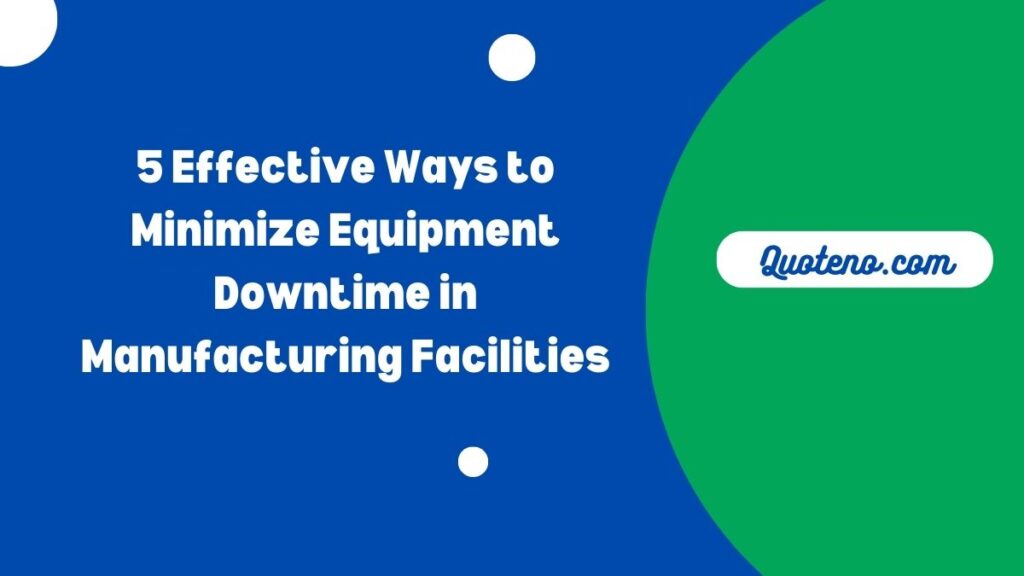Manufacturing equipment often needs to work non-stop for the entire workday, sometimes even 24/7. In cases when a machine malfunctions and stops working, these downtimes can be frustrating, expensive, and even dangerous. When one machine stops, usually the entire production line needs to be brought to a halt.
But with a few effective strategies, downtime can become a thing of the past. Let’s examine these strategies and see how you can apply them on your factory floor.
Table of Contents
Stay on top of maintenance
Preventive maintenance is the first line of defense against unforeseen interruptions. The goal is to prevent waiting for equipment to fail. Instead, be proactive. Develop a detailed maintenance plan for all of your equipment based on manufacturer guidelines and industry best practices.
This schedule should include routine inspections, maintenance, and replacement of worn components before they fail. Keep a close eye on your machines’ health to ensure they are always in top condition.
Prioritizing preventative maintenance means that you are not merely reacting to problems as they happen; you are actively avoiding problems from occurring in the first place or delaying them as much as possible. This strategy ensures that your manufacturing line operates smoothly and continuously.
Train your team well
Your team must be proficient in both operating and maintaining the equipment, and for them to do that, you must invest in their training and development. Comprehensive training goes beyond simple operation manuals. It encompasses hands-on training for equipment operation, understanding the nuances of each piece of equipment, and basic troubleshooting skills.
A well-trained team can recognize when a machine isn’t performing at its best and catch small issues before they escalate into costly downtimes. Encourage a culture where learning is continuous, and knowledge sharing is standard practice.
By investing in your team’s skills, you’re reducing risk, empowering your team, and creating a more resilient and efficient manufacturing environment.
Implement equipment monitoring systems
To put it simply, equipment monitoring means detecting problems before they escalate. During normal operation, each piece of machinery has a unique baseline of vibration. When something is wrong—such as misalignment, unbalance, or wear and tear—the vibration pattern changes.
By integrating effective vibration monitoring, you are giving your equipment a continuous health check. This proactive strategy enables you to plan maintenance or repairs before a minor issue escalates into a full-fledged operational disaster.
For a more in-depth look at how this works and the benefits, find your experts in condition-based monitoring services, including vibration analysis, and don’t hesitate to ask all the questions. It’s a smart move towards smarter manufacturing.
Stock up on spare parts
Suppose your production line comes to a standstill owing to a major component failure, and you’re left twiddling your thumbs while waiting for a replacement part to arrive. Maintaining a well-stocked supply of replacement parts can be lifesaving. Take an inventory of your equipment and determine the most critical components that are likely to fail.
Then, make sure you keep an emergency supply of these parts available. When something goes wrong, instead of scrambling to buy replacement parts and waiting for delivery, you can just use your pre-stocked storage. This way, you can prepare for the worst-case scenario while being proactive and in charge of your downtime.
Embrace technology and automation
Manufacturing is no longer synonymous with manual work and grease-stained overalls. Technology and automation reign supreme nowadays. You can use these technologies to reduce downtime and increase efficiency in your facility.
There are several technology options available to help you reduce downtime, including adopting real-time equipment health monitoring software or investing in AI-powered predictive maintenance solutions. Embracing technology will help you keep up with the times and give your facility the competitive advantage it needs.
High levels of productivity are not just a dream for every manufacturer. Today, with technology, good training, and good preparation, you can truly minimize downtime and maximize efficiency.
As a side effect of your strategies, you’ll boost the overall performance of your facility and keep you one step ahead of the competition. Implement these strategies above, give them some time to work, and it won’t take long to notice a huge improvement in your downtime.
- How to Track and Measure the Effectiveness of Your Marketing Campaigns - July 26, 2024
- 5 Reasons Architects Should Learn Computational Design - April 15, 2024
- How to Look After Your Health While Traveling Abroad - February 23, 2024

